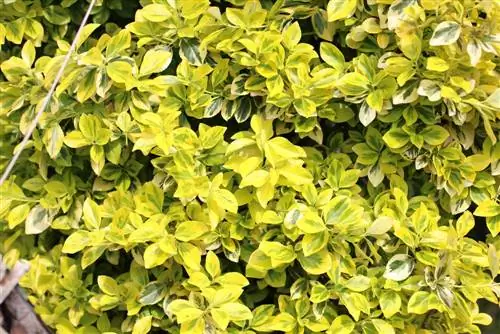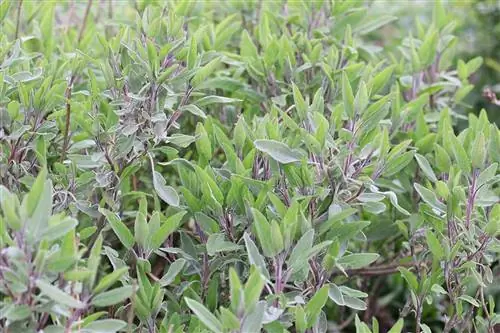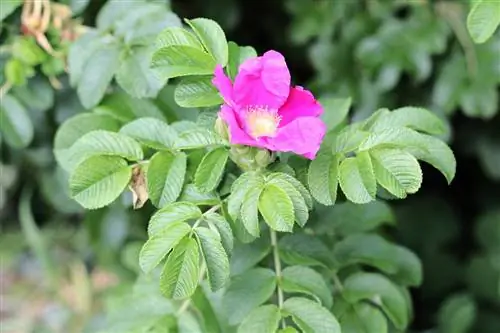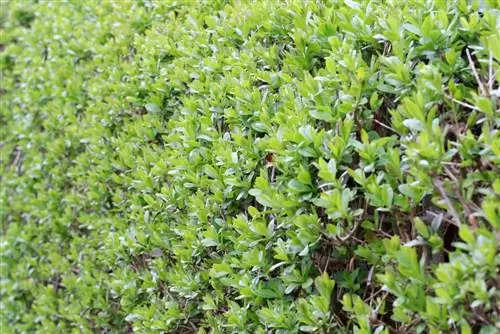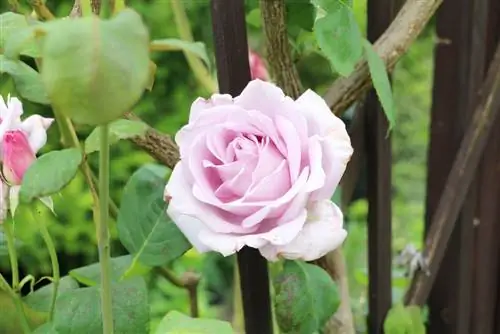- Author admin [email protected].
- Public 2023-12-17 03:39.
- Last modified 2025-06-01 06:48.
A golden privet sets elegant accents in the creatively designed garden with a unique play of colors of its oval golden yellow and delicate green variegated leaves. A white panicle flower appears in summer, followed by shiny black berries in autumn. The spectacular shrub displays these remarkable attributes just as impressively as an imposing solitaire and as a shapely hedge. To enjoy all of these benefits, the following care and cutting recommendations should be followed.
Profile
- Plant family of the olive family (Oleaceae)
- Genus: Privet (Ligustrum)
- Variety of oval-leaved privet (Ligustrum ovalifolium 'Aureum')
- native to Japan, Korea and China
- semi-evergreen shrub with a tightly upright habit
- typical characteristic: golden variegated foliage
- Growth height 180 to 280 cm
- white panicle flowers from June to July
- shiny, black berries in autumn
Use as a solitaire, hedge plant and small tree
The pea-sized berries are a popular source of food for garden birds. However, the fruits are inedible for humans and cause considerable discomfort.
Location
The appropriate location plays a key role in care. This privet variety only develops its golden colors in sunny locations. The further the ornamental shrub moves into semi-shady lighting conditions, the more its foliage turns green. In addition, the decorative flowers are somewhat sparser, with a correspondingly reduced amount of fruit. However, this circumstance does not diminish his well-formed, taut habitus. With regard to soil conditions, a Ligustrum ovalifolium Aureum adapts to any good garden soil. It reaches its optimum in this soil:
- humic, nutrient-rich and not too dry
- deep with good water drainage
Pouring
Due to the extremely dense foliage, a golden privet evaporates a lot of moisture. If the natural amount of rainfall leaves something to be desired, the gardener is required to compensate for the loss of water through regular watering. The younger the bush, the higher the water requirement.
- water freshly planted golden privet daily
- water established shrubs regularly
- A mulch layer of leaves, grass or lawn clippings keeps the soil moist
- drooping leaves signal drought stress
Experienced hobby gardeners do not let mild summer rain fool them into the fact that the root zone requires moisture. Therefore, in warm summer periods, they use the hose at least once or twice a week to thoroughly water golden privet, even immediately after a gentle rain shower.
Fertilize
The energy requirement is high to produce such colorful foliage, beautiful flowers and decorative fruit. When it comes to nutrient requirements, a Ligustrum ovalifolium Aureum should not be neglected.
- Administer a slow-release fertilizer at the end of March and beginning of August.
- Alternatively, work compost and horn shavings into the soil every 14 days during the growing season.
- Apply a liquid fertilizer for green plants in the bucket according to the manufacturer's dosage instructions.
From the second half of August, the shrub no longer receives any additional nutrients. This gives the shoots enough time to mature before winter and withstand frosty temperatures.
Tip:
When working with the soil, remember that golden privet is a shallow-rooted plant. Organic fertilizer is only raked in superficially without damaging the roots.
Cutting
Thanks to its outstandingcutability, a gold privet can be flexibly shaped. In this context, it should be borne in mind that it does not develop its dense habitus naturally, but requires supportive intervention from the gardener. This applies to cultivation as a solitaire as well as to use as a hedge. The ideal location alone does not produce the perfect aureum, but only in combination with the followingCutting measures can the feat be achieved:
- Cut privet immediately after planting to 15 cm above the ground.
- Let the new shoots grow undisturbed by 25 to 30 cm.
- When the total height is 40 to 50 cm, shorten the bush again by 5 cm.
- Strong-growing specimens may be cut every 4 weeks.
In this way you will achievedense growth in the lower part of the bush. If you can't bring yourself to do the radical planting cut, you'll initially get a higher golden privet right from the start. However, this quickly becomes thinner and bare from below. Concentrating on a compact base with a little patience at the beginning will be rewarded in the long run. With an annual growth of up to 40 cm, a golden privet still reaches the desired height within a short time.
Cutting rhythm
The following cutting rhythm is recommended for the established shrub:
- The first shape and maintenance cut takes place in the spring before budding.
- Remove all dead wood from the golden privet, including any frozen branches.
- Cut out shoots that are directed towards the interior of the bush or that cross each other.
- Short the bush all around to the desired length.
- Ideally shape a hedge into a trapezoid shape.
- After flowering, carry out a second pruning, preferably after St. John's Day.
When cutting, the focus is on cutting each shoot just above an outward-facing bud. In this way you encourage even more intensive branching of the ornamental shrub. If you hold the scissors at a slight angle, rain and irrigation water can drain away more quickly, which significantly reduces the risk of infection until the wound closes.
The autumn cut - advantages and disadvantages
Following the summer cut around St. John's Day at the end of June, a golden privet is busy sprouting again. That's why hobby gardeners reach for scissors in the fall for one last topiary cut of the season. This has the advantage that the ornamental shrub presents an accurate appearance for many months during the cold season. In this context, it should be borne in mind that any pruning will result in increased sprouting. For a strong-growing Ligustrum ovalifolium Aureum, this means a large number of young shoots that cannot mature before the first frost. They fall victim to the winter and weaken the overall constitution of the shrub.
Tip:
Deep cutting measures on bushes may not be carried out from March 1st to September 30th. During this time, breeding birds colonize leafy trees and, in accordance with nature conservation law, may not be disturbed or even driven away.
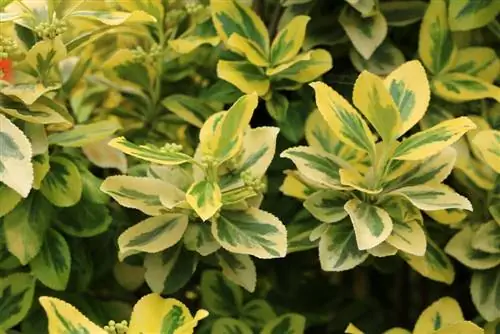
Conclusion
With the gold privet, a special piece of jewelry moves into the garden. The privet variety is very popular as a robust ornamental shrub with golden variegated foliage, white summer flowers and dramatic berries in autumn. The Ligustrum ovalifolium Aureum owes its popularity not only to its elegant, taut habit. Its undemanding care, combined with its good tolerance for pruning, make it the ideal hedge plant. The pivotal point of successful cultivation is the age-appropriate execution of cutting measures. Anyone who is sufficiently informed in this regard will be rewarded with a magnificent gold privet for many years.
What you should know about gold privet in brief
- The golden privet (Ligustrum ovalifolium Aureum) is a hardy and wintergreen shrub.
- It is a variant of the oval-leaved privet (Ligustrum ovalifolium) and can be combined well with these plants.
- Due to its fast growth and also because of its upright, densely branching growth habit, it is very suitable as a hedge plant.
- The hedge plant owes its name to its green-yellow or golden-yellow foliage. Creamy white flowers appear in spring.
- As with the oval-leaved privet, the golden privet also produces spherical, black fruits.
- Its flat roots are densely branched. Therefore it can also be cultivated in pots or plant troughs.
- Three plants are needed per square meter of hedge. The annual growth is 20 to 40 cm per year.
- This hedge plant can reach a height of approx. 150 to 200 cm and is between 50 and 110 cm wide.
- The plants should be planted at a distance of about half a meter from the fence.
Cutting
- As a hedge, as with other hedge plants, a slightly conical shape should be achieved. This means that the lower leaves also receive enough sun.
- Pruning can basically take place all year round, with the exception of forestry and extreme heat and drought.
- A cut around St. John's Day (June 24th) is recommended. Because at this point most plants have a growth phase.
- As a rule of thumb, the more often you cut, the more densely the hedge will branch.
- Before pruning, check whether there are any birds nesting in the hedge.
Care
- A sunny to semi-shady location is suitable for the golden privet. It grows in normal garden soil.
- In case of very severe frost, a winter protection cover is recommended.
- The golden privet can be used as a hedge, solitary plant and as a wind and privacy screen.
- A complete fertilizer can be used for fertilization. This is administered two to three times a year from April to the end of July.
- Regular watering and avoiding waterlogging are also important so that the golden privet thrives.
Tip:
If a golden privet is to be transplanted, the frost-free period between mid-October and the end of April is recommended.

